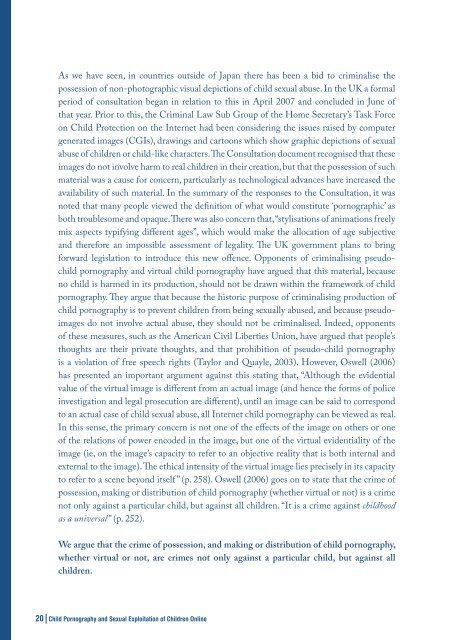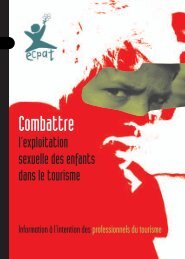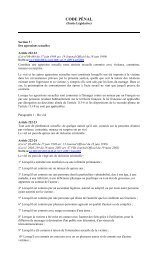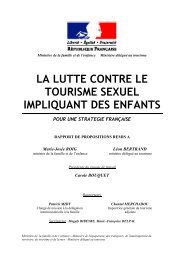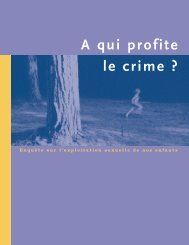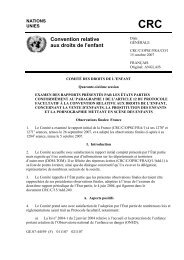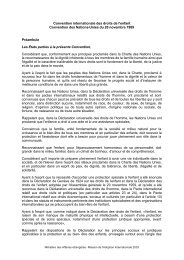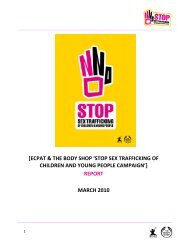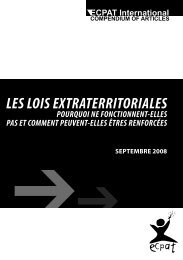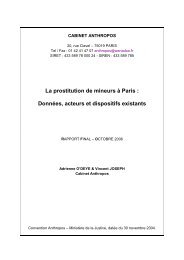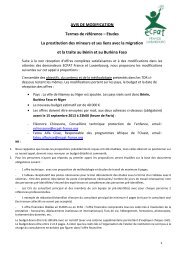child pornography and sexual exploitation of children online
child pornography and sexual exploitation of children online
child pornography and sexual exploitation of children online
You also want an ePaper? Increase the reach of your titles
YUMPU automatically turns print PDFs into web optimized ePapers that Google loves.
As we have seen, in countries outside <strong>of</strong> Japan there has been a bid to criminalise the<br />
possession <strong>of</strong> non-photographic visual depictions <strong>of</strong> <strong>child</strong> <strong>sexual</strong> abuse. In the UK a formal<br />
period <strong>of</strong> consultation began in relation to this in April 2007 <strong>and</strong> concluded in June <strong>of</strong><br />
that year. Prior to this, the Criminal Law Sub Group <strong>of</strong> the Home Secretary’s Task Force<br />
on Child Protection on the Internet had been considering the issues raised by computer<br />
generated images (CGIs), drawings <strong>and</strong> cartoons which show graphic depictions <strong>of</strong> <strong>sexual</strong><br />
abuse <strong>of</strong> <strong>child</strong>ren or <strong>child</strong>-like characters. The Consultation document recognised that these<br />
images do not involve harm to real <strong>child</strong>ren in their creation, but that the possession <strong>of</strong> such<br />
material was a cause for concern, particularly as technological advances have increased the<br />
availability <strong>of</strong> such material. In the summary <strong>of</strong> the responses to the Consultation, it was<br />
noted that many people viewed the definition <strong>of</strong> what would constitute ‘pornographic’ as<br />
both troublesome <strong>and</strong> opaque. There was also concern that, “stylisations <strong>of</strong> animations freely<br />
mix aspects typifying different ages”, which would make the allocation <strong>of</strong> age subjective<br />
<strong>and</strong> therefore an impossible assessment <strong>of</strong> legality. The UK government plans to bring<br />
forward legislation to introduce this new <strong>of</strong>fence. Opponents <strong>of</strong> criminalising pseudo<strong>child</strong><br />
<strong>pornography</strong> <strong>and</strong> virtual <strong>child</strong> <strong>pornography</strong> have argued that this material, because<br />
no <strong>child</strong> is harmed in its production, should not be drawn within the framework <strong>of</strong> <strong>child</strong><br />
<strong>pornography</strong>. They argue that because the historic purpose <strong>of</strong> criminalising production <strong>of</strong><br />
<strong>child</strong> <strong>pornography</strong> is to prevent <strong>child</strong>ren from being <strong>sexual</strong>ly abused, <strong>and</strong> because pseudoimages<br />
do not involve actual abuse, they should not be criminalised. Indeed, opponents<br />
<strong>of</strong> these measures, such as the American Civil Liberties Union, have argued that people’s<br />
thoughts are their private thoughts, <strong>and</strong> that prohibition <strong>of</strong> pseudo-<strong>child</strong> <strong>pornography</strong><br />
is a violation <strong>of</strong> free speech rights (Taylor <strong>and</strong> Quayle, 2003). However, Oswell (2006)<br />
has presented an important argument against this stating that, “Although the evidential<br />
value <strong>of</strong> the virtual image is different from an actual image (<strong>and</strong> hence the forms <strong>of</strong> police<br />
investigation <strong>and</strong> legal prosecution are different), until an image can be said to correspond<br />
to an actual case <strong>of</strong> <strong>child</strong> <strong>sexual</strong> abuse, all Internet <strong>child</strong> <strong>pornography</strong> can be viewed as real.<br />
In this sense, the primary concern is not one <strong>of</strong> the effects <strong>of</strong> the image on others or one<br />
<strong>of</strong> the relations <strong>of</strong> power encoded in the image, but one <strong>of</strong> the virtual evidentiality <strong>of</strong> the<br />
image (ie, on the image’s capacity to refer to an objective reality that is both internal <strong>and</strong><br />
external to the image). The ethical intensity <strong>of</strong> the virtual image lies precisely in its capacity<br />
to refer to a scene beyond itself ” (p. 258). Oswell (2006) goes on to state that the crime <strong>of</strong><br />
possession, making or distribution <strong>of</strong> <strong>child</strong> <strong>pornography</strong> (whether virtual or not) is a crime<br />
not only against a particular <strong>child</strong>, but against all <strong>child</strong>ren. “It is a crime against <strong>child</strong>hood<br />
as a universal” (p. 252).<br />
We argue that the crime <strong>of</strong> possession, <strong>and</strong> making or distribution <strong>of</strong> <strong>child</strong> <strong>pornography</strong>,<br />
whether virtual or not, are crimes not only against a particular <strong>child</strong>, but against all<br />
<strong>child</strong>ren.<br />
20|Child Pornography <strong>and</strong> Sexual Exploitation <strong>of</strong> Children Online


